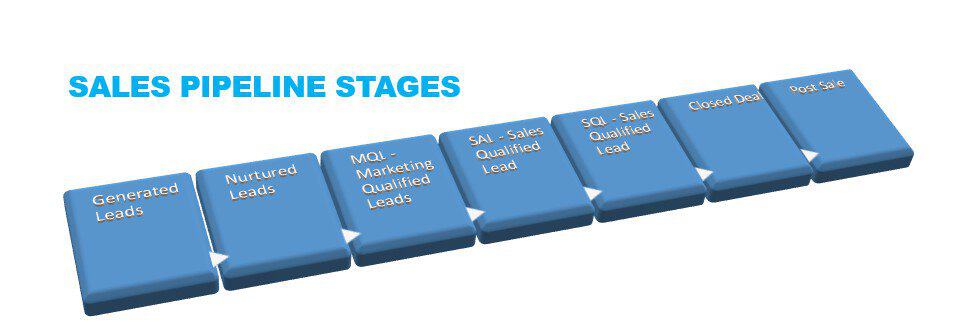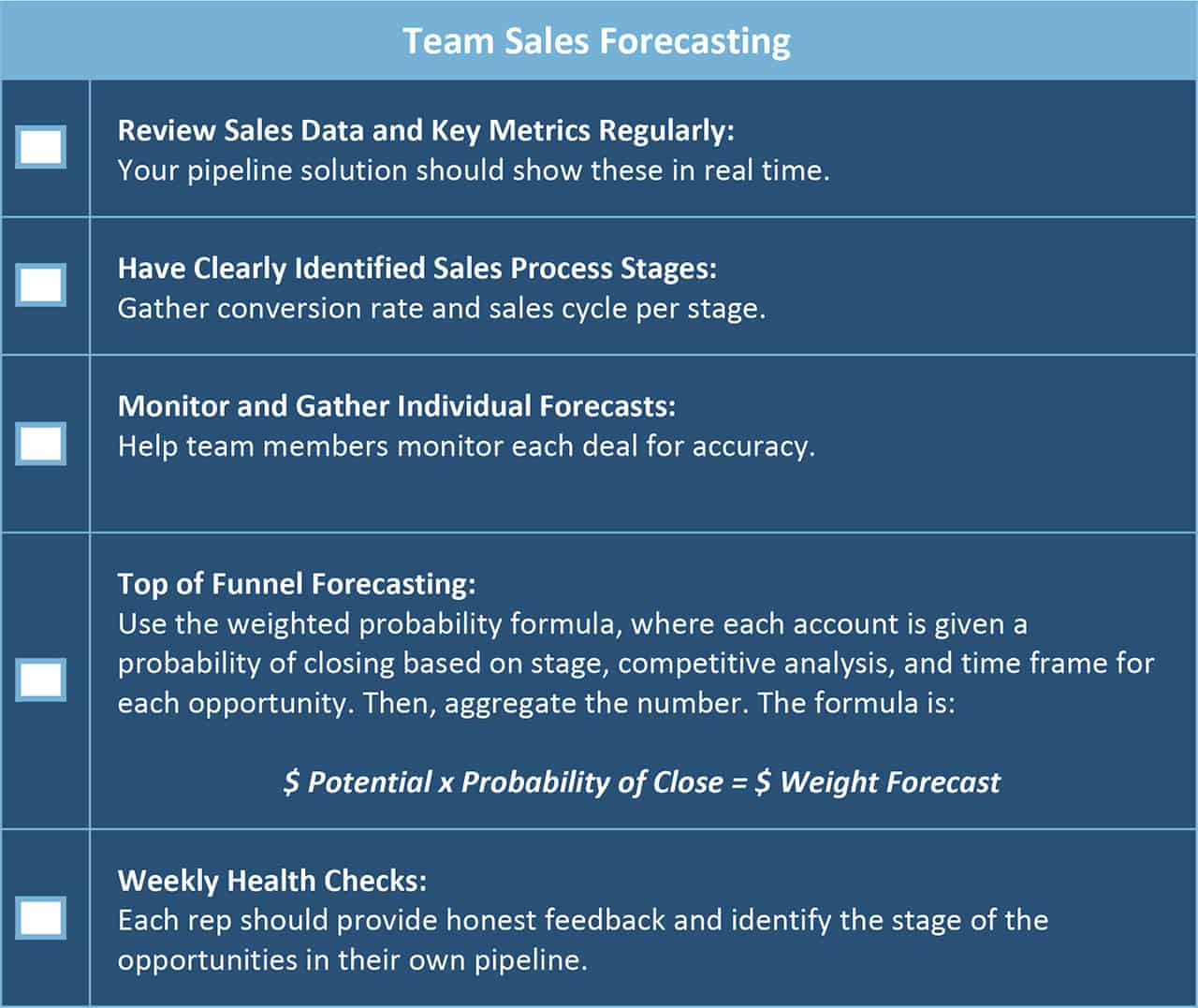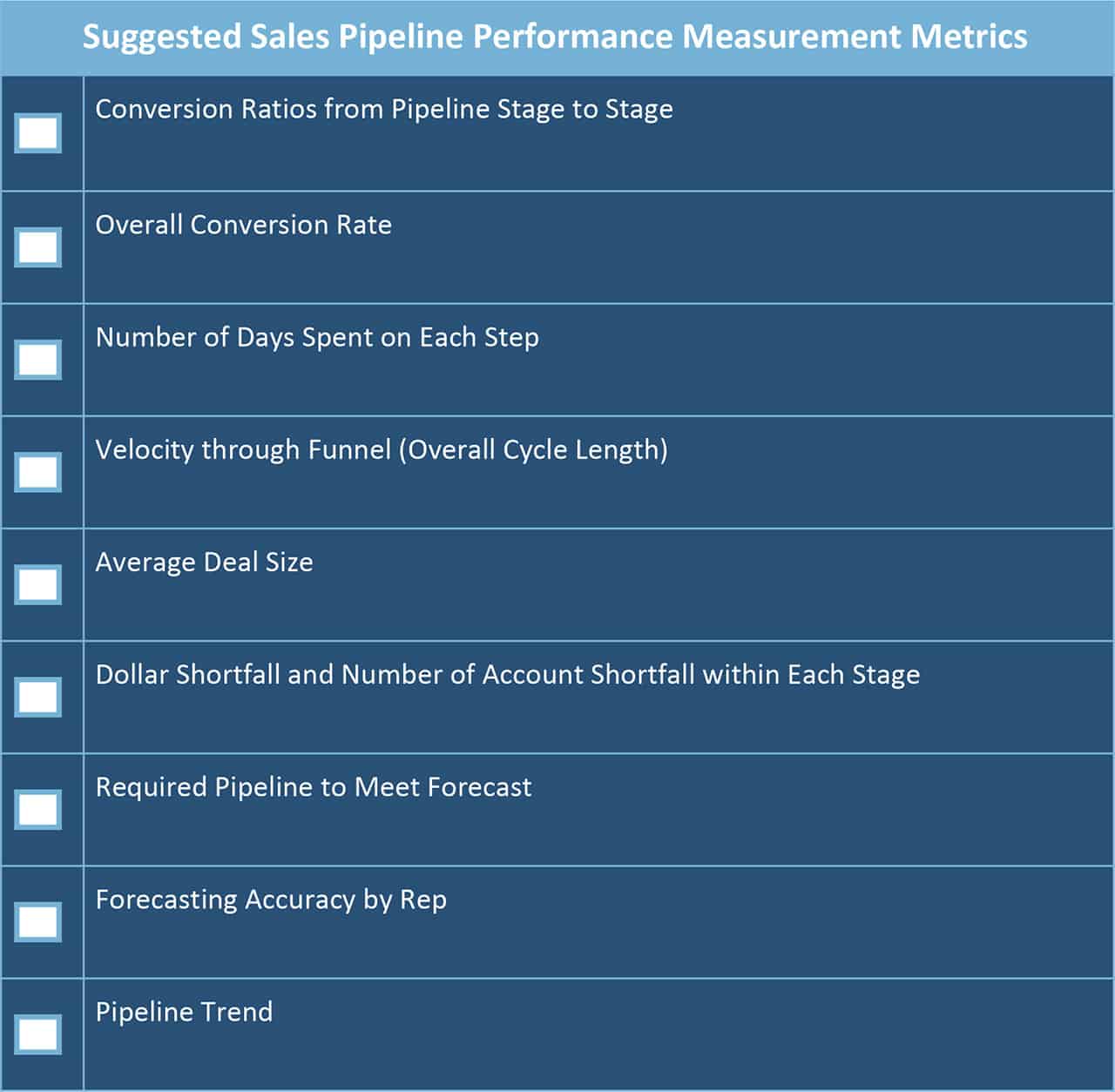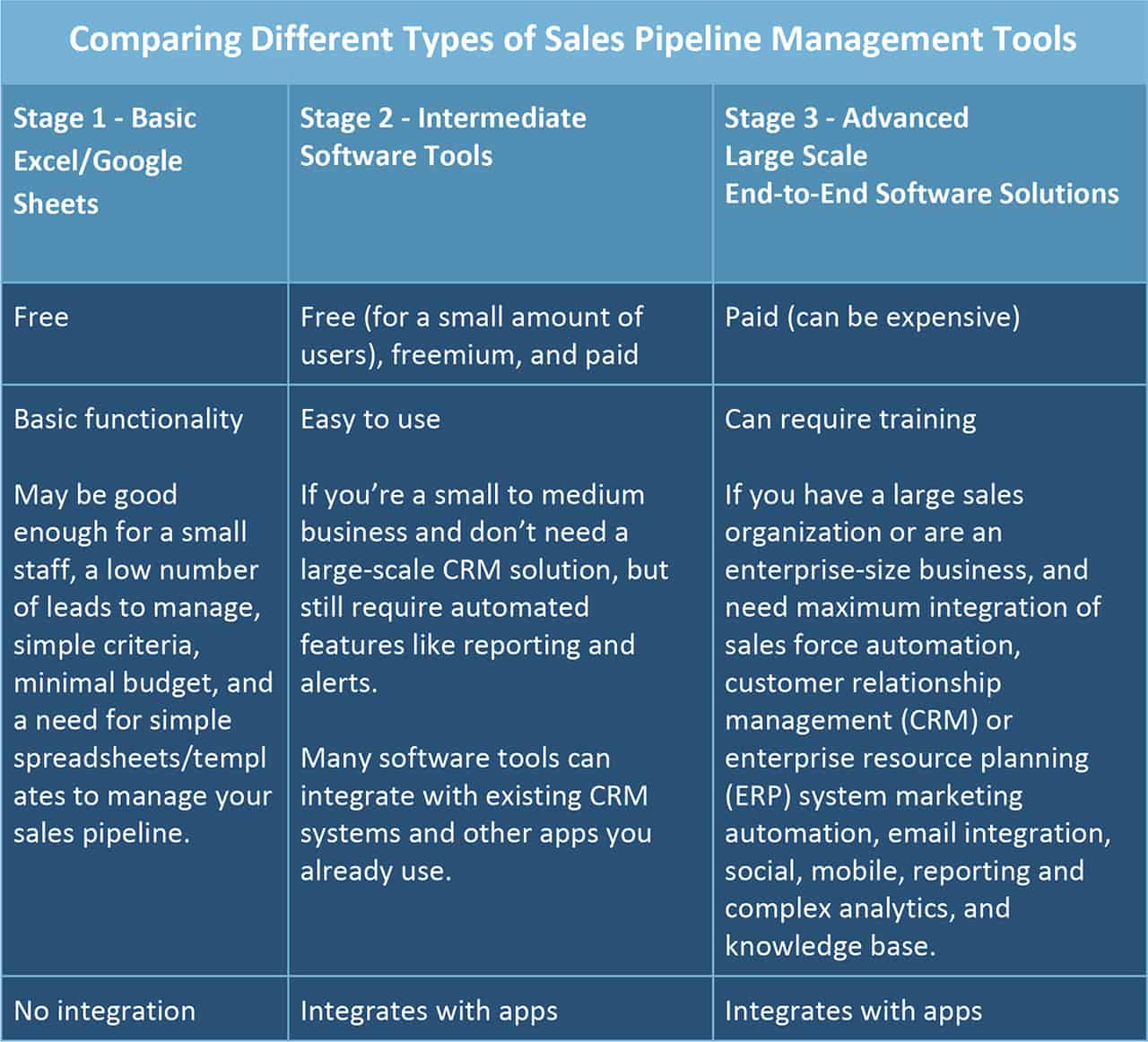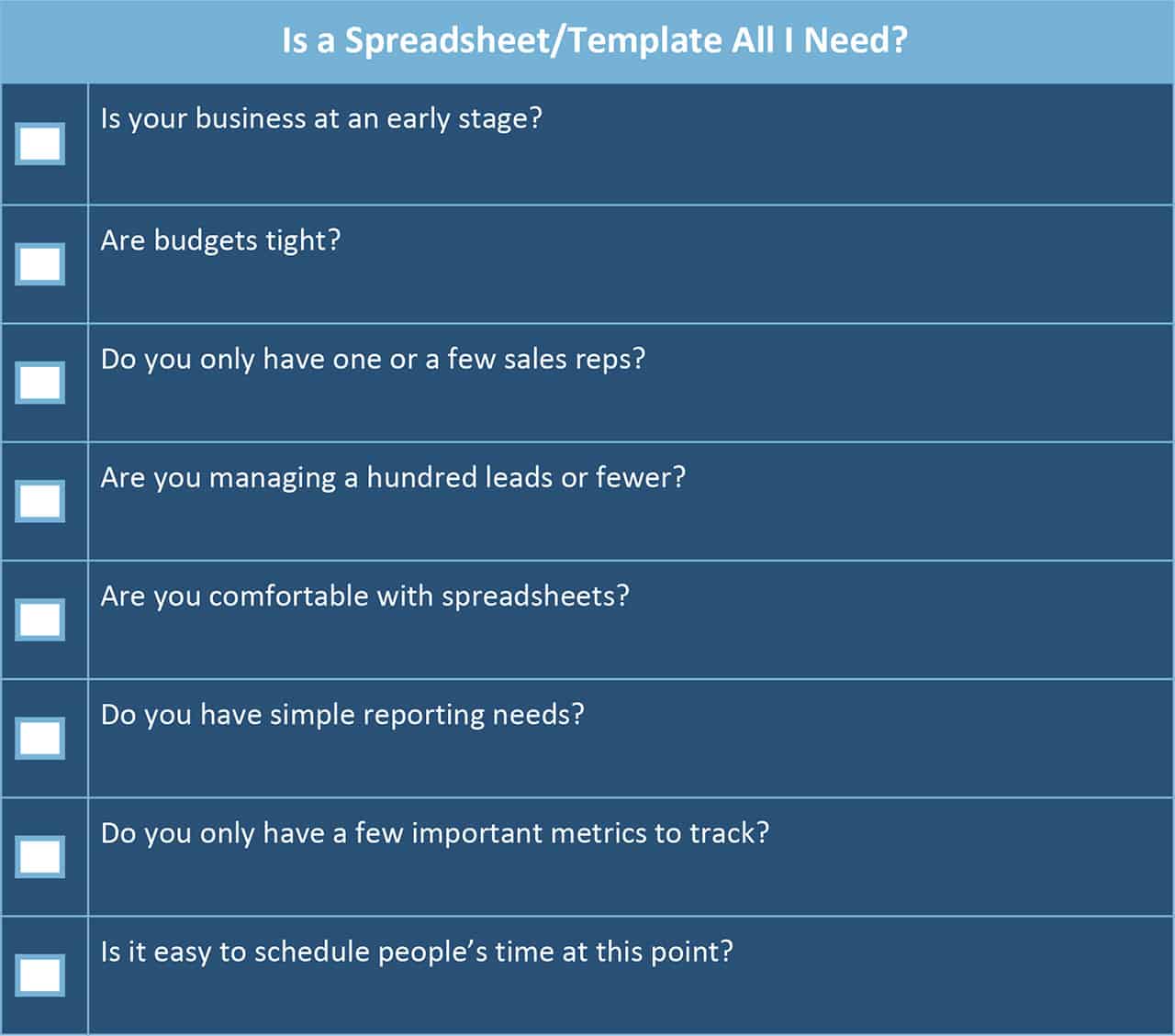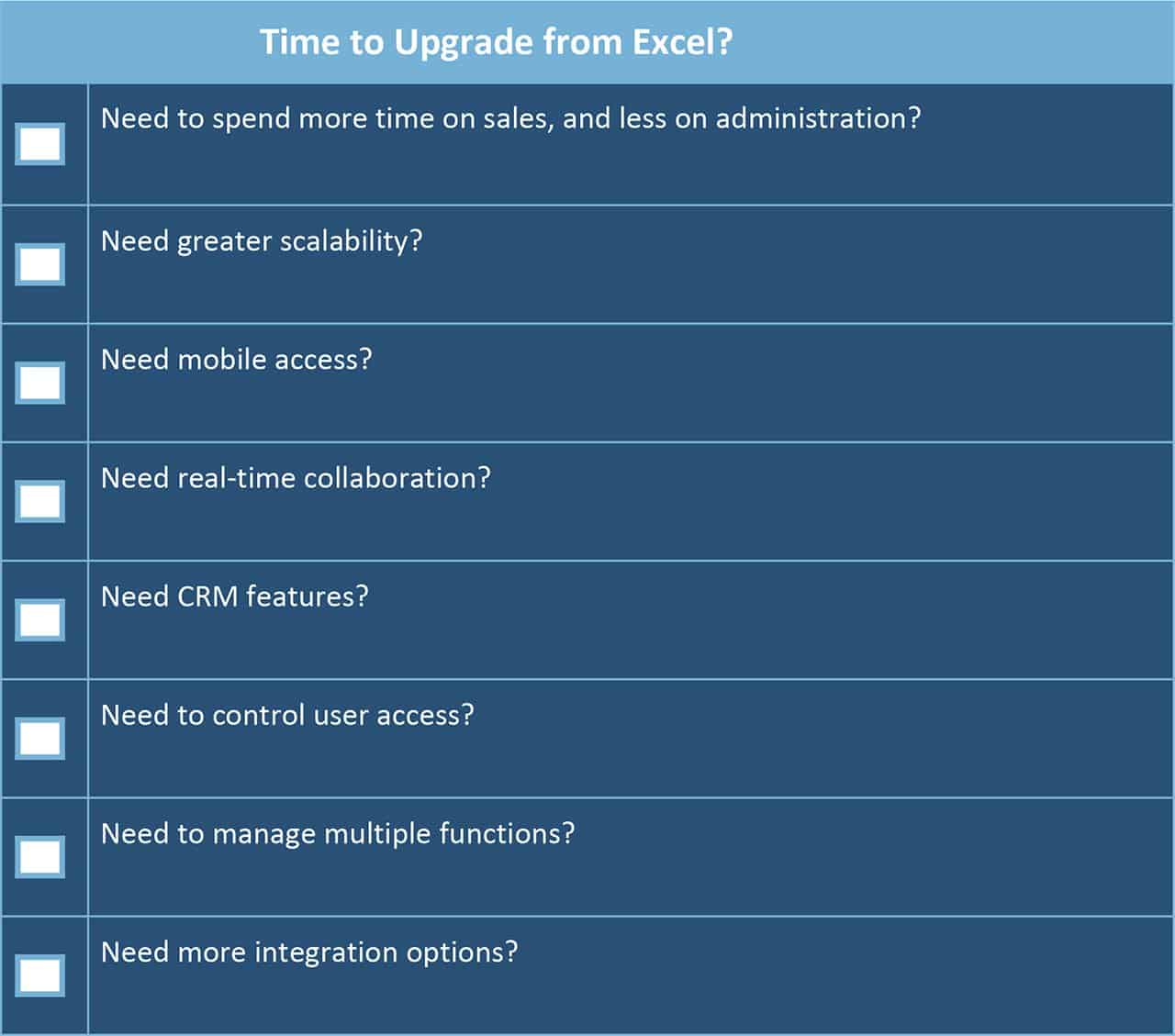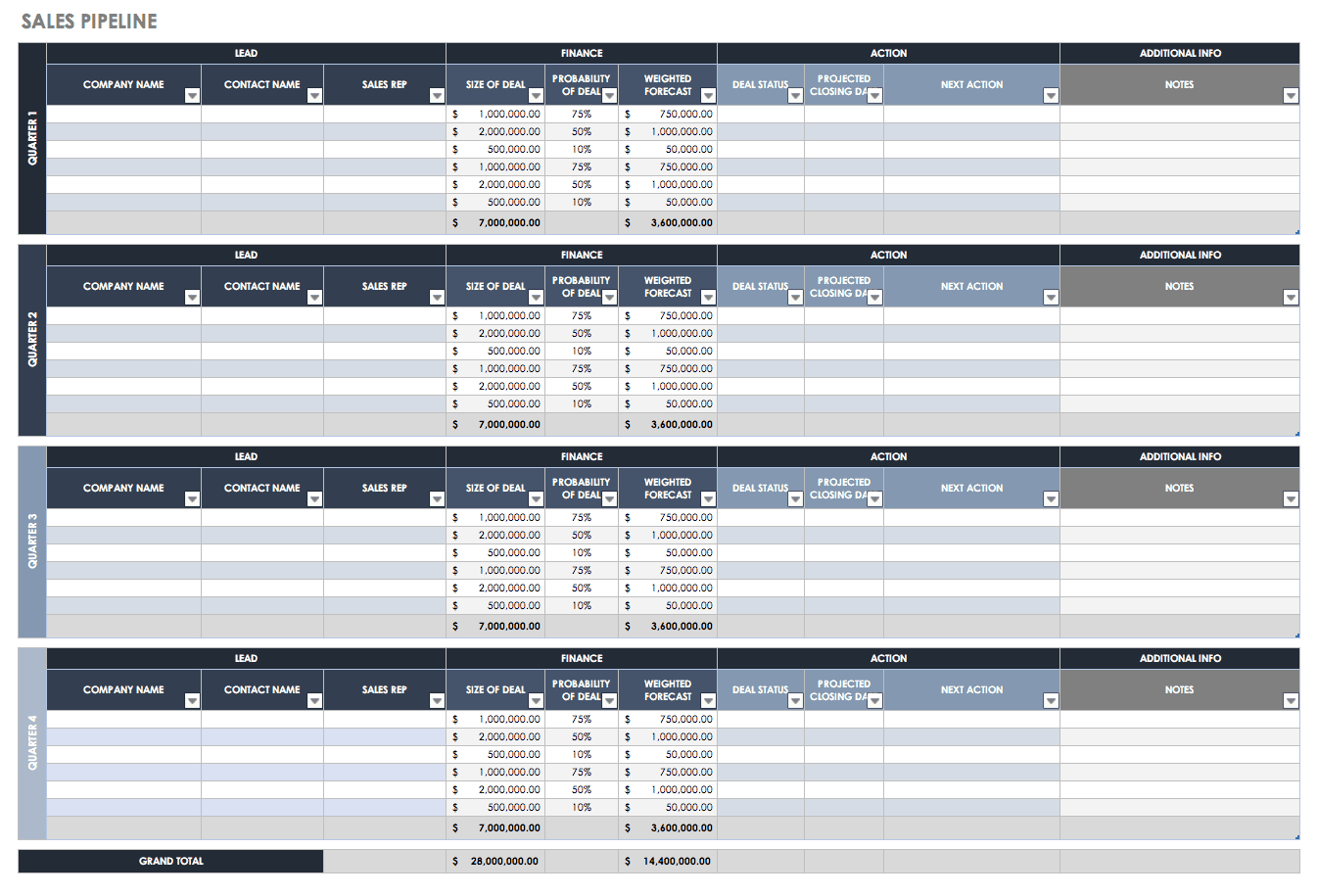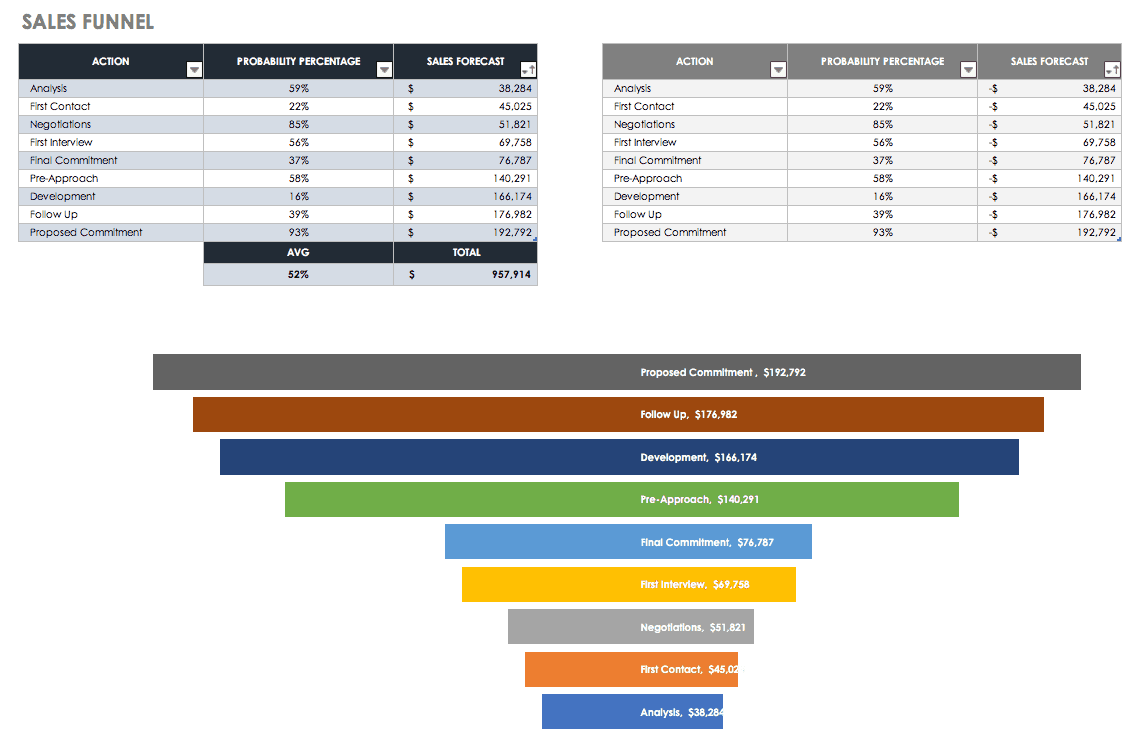What Is Sales Pipeline Management?
A sales pipeline provides visibility into sales prospects as well as valuable information about where they are on their journey to purchasing your product or service. The right software tools should help you closely manage and monitor your sales pipeline, and ensure that you don’t miss opportunities, with:
- A Quick Quota Scan for the Present: Look into each sales rep's account forecast to see if they are hitting their numbers, and to get an idea of how close the entire team is.
- A Forecasting Tool for the Future: This shows sales rep and managers which businesses will close within a given period of time, along with historical information about the customer.
- A Look into Past History: By tracking metrics over time, you can assess sales opportunities during specific selling periods, understand the health of your pipeline and business, and evaluate rep performance and forecast.
- A Way to Clearly Communicate: Goals, current status, where pipeline backups are occurring, deal sizes, and more are visible to everyone on the team.
- An Analysis and Strategy Tool: The pipeline helps create appropriate strategies to move things in the right direction if sales are lagging.
- A Pathway to Success: When you take control of your pipeline, you can focus on the right deals and prospects. It simplifies what needs to be done to produce sales now and can help make them easier in the future.
But when you’ve gone from two sales people and a hundred leads in your pipeline to thousands of leads and a hundred sales reps, what happens? Getting to an efficient and effective sales pipeline comes with complexities that increase as your sales team succeeds.
To sort out the ins and outs of B2B sales pipelines and how to decide on the right pipeline solution for your company - a spreadsheet or an end-to-end solution - we looked to an expert in sales pipeline management.
Organizing Sales Complexity Using Stages
When you consider all the moving parts involved in B2B sales (and the increasing demands in the ‘age of the consumer’), it becomes critical to use stages as the organizing principle to align sales to your customer’s buying process. “The thing that I’ve learned to grow business is to understand what stage your company is in it’s evolution and exactly what you want to achieve,” says Hayes. “Everything flows from that and can determine what kind of tools you need to use at any given time.”
Sales reps also go through stages. “There are stages the sales team goes through as you become more sophisticated,” says Hayes. “For example, if you’re a startup, do you have inbound leads yet, or do you need to go outbound? If no one is contacting or calling you, then you need to network to get those first opportunities. So the answer for selecting the sales pipeline solution also depends on where you are in the company lifecycle.”
Sales Pipeline Stages and Your Company’s Success
The Harvard Business Review reports, “Companies that use a scientific approach to sales force effectiveness have found that reps in the lower quartiles show dramatic improvement, with productivity jumps of 200 percent.” Making your process formal, data driven, and repeatable are best practices that reap rewards for the sales team and the entire organization. As Hayes notes, the basis of the process is the pipeline stages or steps.
- Lead Generation: This is the first stage that brings people to you through email, events, or attracting prospects through content that helps you capture their contact information.
- Lead Nurturing: Here’s where you develop the early relationship and engage with the potential customer, answer their questions, and begin to lead score for value.
- Marketing Qualified Lead (MQL): An MQL is ready to interact with a human based on the demographics, activities, and behaviors you’ve identified from your customer profile.
- Sales Accepted Lead (SAL): An SQL is an MQL that has been sent to the sales team for approval.
- Sales Qualified Lead (SQL): An SQL has been given the stamp of approval and is ready to make a purchase.
- Closed Deal: Success! You’ve made the sale. However, the work doesn’t stop there.
- Post-sale: Keep in touch, keep your promises, and ask for referrals.
To learn more about these stages, check out Sales Pipeline Management 101, Stages, Managing and Tips.
Forecasting at Every Stage of the Sales Pipeline
Forecasts are an important tool because they enable companies to make informed business decisions. Unfortunately, reporting sales projections tends to be something that sales reps and managers don’t like to do, but the right strategy and pipeline tool can make some of the pain disappear. You can base forecasts on past sales data, industry-wide comparisons, and economic trends.
Sales managers can use this five step checklist to create more accurate forecasts:
Download Team Sales Forecasting Checklist
Forecasts are the bane of every rep’s and manager’s existence, but they are a necessity and need to be accurate. A Forbes article, Four Principles for Great Sales Forecasts, identifies ways to make sales pipeline forecasts more precise:
- Solid Sales Strategy: Include customer criteria and a SWOT analysis to build a closing system. You also need to verify that you have the right prospects in your pipeline. If they are worth having in the queue, build a sales strategy that addresses who they are and what you will do to solve their problems.
- Customer Knowledge: You can never analyze your customer’s behavior closely enough. So, do continuous research and adapt to change.
- Milestone-driven Pipeline Process: The seven step version covered earlier clarifies the stages, but your customers may behave differently or you may want to break down achievements into smaller increments. Doing the work upfront will help you increase sales more easily in the future.
- Continuous Improvement: Everything changes, as no pipeline or customer behavior set remains the same. Continuous improvement, scrutiny of historical data, and current research help keep customers and the C-Suite happy with what you’re delivering.
The Sales Pipeline Is a Powerful Communication Vehicle
A defined sales pipeline and an effective solution provide the sales team with visibility into the process. However, it also supports the entire company:
- Manufacturing can use the pipeline to plan production
- Finance can use results to plan revenues and cash flow
- Product development can use the pipeline to understand what is seling and see requests in advance of order placements
- C-Suite and board can use information from the pipeline to understand business momentum and communicate with shareholders
Most importantly, the sales department can communicate regularly about real data based on where you are in the sales process, where the pipeline is clogged, and where it’s moving with velocity. The team can share that data with the company and make adjustments when closings need to be expedited.
Lead Generation Stages and Online Marketing
To get buyers into the pipeline, you must have lead generation that stimulates and captures interest in a product or service.
“When you have just one person selling, if they don’t yet have any inbound leads, managing a pipeline is a lot easier with something like LinkedIn and a spreadsheet (you can export to your CSV file),” says Hayes. “But once you start adding more leads or more salespeople, you need to be able to scale and take advantage with a tool.”
Digital channels and social media have been a game-changer for marketing and sales. They’ve grown the number of self-directed buyers and offer better ways to develop and qualify leads before sending them to sales through automated demand generation. Instead of finding customers with mass ads and spammy email, sellers can focus on being found and learn to build engaged customer relationships.
Hayes says that making larger sales these days may not be all about finding the purchaser from the start. He highly recommends reading The Challenger Customer: Selling to the Hidden Influencer Who Can Multiply Your Results by Brent Adamson. “C-level people don’t buy these days. You need to find the people who have the passion to reinvent or change how an organization is doing something to make it better. If you can break down issues for skeptics, they become a believer and will drive you through and help you make the connections, get buy-in, and ultimately make the sale.”
Sales Pipeline Management Success Metrics
To have a logical, repeatable, and observable sales pipeline process, you need to identify the key sales metrics or key sales performance indicators (KPIs) that will move opportunities through the pipeline to closing at a higher velocity. Regular monitoring can help identify bottlenecks and unclog your pipeline.
One major concern is how long it takes to close deals from start to finish. Here are two formulas to help speed your sales:
Simple Pipeline Size by Rep Formula
Sales quota ÷ close rate = ideal pipeline size per sales rep
Sales Pipeline Velocity Formula
Number of Opportunities x Average Sale Dollar Amount x Percentage of Sales ÷ Sales Cycle Length = Velocity
Other sales metrics to measure success will be unique to your buyers and company. For ideas about developing your own key sales metrics, look into New Insight Into Key Sales Metrics and use this customizable checklist:
Download Suggested Sales Pipeline Performance Measurement Metrics Checklist
Choosing the Right Sales Pipeline Management Solution for Your Company
Whatever sales pipeline management solution you choose - free or paid - should help you visualize your pipeline, and be customizable and intuitive to use. The pipeline solution should also match your sales process, enable you to plan activities, track details, easily manage deals, and allow you to automate functions.
“One of the main questions to answer is just how much functionality you need,” says Hayes. “And you also want to look to the future. Look at competitors who are nine months ahead of you and figure out what they are using. If you’re an early stage business with access to capital, you may go for a solution off the bat. But if you’re underfunded, Excel might be good enough until you can afford a more luxurious solution.”
Selecting a Sales Pipeline Spreadsheet
For a small team that is just starting to build a pipeline, Excel or Google Drive/Docs/Calendar may be enough. “Are you at stage one in your company, with just one or two people in sales so far? If so, then Excel can be a great fit,” advises Hayes. “You keep calling to your list, add referrals, and set reminders to call them back. All that can be tracked simply, and for a great price!”
Download Is a Spreadsheet/Template All I Need?
Are spreadsheets right for you? If so, explore the options available in Free Sales Plan Templates for Excel and Word.
The Next Stage: Sales Pipeline Software Management Solutions
“When we started Koru – I had an article hit the press and we logged all the inbound calls in our CRM. The system told me when I last called, so I could look back at that information. Now, we are scaling up and getting to the next stage, and looking for outbound appointments,” explains Hayes. “Our next strategic project is to fill out the holes in our list – we have several thousand names now, a thousand companies, chief executives, talent teams in some cases, and we have some leads in sales. We also have a purchased data source. How do we book appointments?”
He goes on to say, “It’s about building blocks. CRMs have everything small companies usually need. But as you begin to get to the stage where you’re booming and there is so much data to handle, it may not be sufficient to support you or your customers. It is ultimately a question of scale.”
There’s a wide variety of free, cloud-based apps (usually for a small number of people) to freemium to paid available. You can start thinking about upgrading by considering some basic criteria:
When to Graduate to a More Sophisticated Sales Pipeline Tool
When you have thousands or hundreds of thousands of leads to handle - plus onsite, offsite, and possibly international reps - handling administration may take up valuable time. At this stage, it’s time to graduate to a more advanced solution that connects to your CRM or Enterprise Resource Planning (ERP) system. “Once you’ve grown a really big pipeline, you need a CRM as almost an accounting solution. It is a resource planning solution and analytics repository that you can use to learn and build strategies to be better,” advises Hayes.
“The next choice to drive sales is to look to add a sales enablement tool with a richer level of integration that allows us to communicate with marketing automation directly from the salesperson,” notes Hayes. “We want to integrate with CRM, at scale, and on a cadence that we’re targeting, and then track those responses. The important thing with our next tool is to know exactly when a person is looking at our content: to tell us that Sally has opened an email, Tom has clicked into material, and that Sarah has replied – in real time. Having the ability to see patterns of information that can help you plan your day, send emails, and a myriad other things can be extremely helpful when it comes to building winning strategies.”
However, Hayes cautions that only you know what you need. “One thing to watch out for is software vendors who are preaching nirvana, but who are not really connecting with what you’re trying to do” he says. “You need to be clear about your requirements, and even then, best-of-breed solutions may not have absolutely everything you need and can integrate with appropriate apps.”
Download Features to Look for in Sales Pipeline Software Solutions Checklist
Sales Pipeline Best Practices
Now that you are ready for the next stage in sales performance, it’s time to focus on best practices. The Harvard Business Review reported research from Vantage Point Performance that found that companies that stressed three best practices saw a 28 percent higher revenue growth than those that did not. Those three best practices are as follows:
- Make it Repeatable: Be sure you have a clearly defined process that is constantly monitored so you can continually improve your process.
- Invest Time: Spend a minimum of three hours a month on pipeline management.
- Training Matters: Train sales managers to understand pipeline management, the reason(s) for your process, and how to use the the sales pipeline solution.
It’s All About the People
Hayes says that at the end of the day, the sales pipeline (and management) is all about people. “Keep and grow the customer, because it’s always harder to get a new one. In tech solutions, you should ask Are they engaging?, Are they a frequent visitor to my site?, Do they buy extra things from me to support their habit?” Keeping customers engaged is a two-way street.
Another important people-related strategy is creating community. “The customer success revolution is all in how to address hundreds or thousands of customers and communicate at scale,” explains Hayes. He adds that tracking relationships long term is essential. “You want to keep them in CRM so you have a view of life cycle – Who is with me two years later or three years later? Look at sources of sales. What makes them stay or go?”
Hayes emphasizes that technology will never replace the human touch. Rather, it will merely enable it - particularly when you’re selling large-ticket or large-scale products or services. “People do buy from people, so engagement is everything. You really want to get people to talk on the phone. It’s important to constantly move toward the next milestone in your sales process and ensure the technology you use helps you in that goal.” He continues, “With large sales like Koru’s, we have between between five and six people in the customers’ organization that are involved in every single buying decision. You need to drive consensus, and that’s a human endeavor. You have to facilitate people so they can actually help with the internal discussions, which is where there is huge value in having a pipeline solution that helps you keep all the requests, questions, conversations - your whole history - organized and constantly moving forward.”
Manage Sales Pipelines with a Pre-Built Template
A sales pipeline template is an effective tool to help you track contacts, estimate how many deals will close, and forecast sales. With a pre-built template you can get started managing pipelines faster than ever. And, depending on your team’s needs, you can determine whether a sales pipeline template in Excel or in Smartsheet is best.
Excel is still a great tool for number crunching, however it was never intended for work management. So use Excel where it makes sense, like calculating deal size and commission, then choose Smartsheet to manage the overall management of the pipeline. Try once of the following templates to help ensure your sales efforts are on track to hit your goals.
Download Sales Pipeline Template
Discover a Simple Sales Pipeline Solution in Smartsheet
Empower your people to go above and beyond with a flexible platform designed to match the needs of your team — and adapt as those needs change.
The Smartsheet platform makes it easy to plan, capture, manage, and report on work from anywhere, helping your team be more effective and get more done. Report on key metrics and get real-time visibility into work as it happens with roll-up reports, dashboards, and automated workflows built to keep your team connected and informed.
When teams have clarity into the work getting done, there’s no telling how much more they can accomplish in the same amount of time. Try Smartsheet for free, today.

